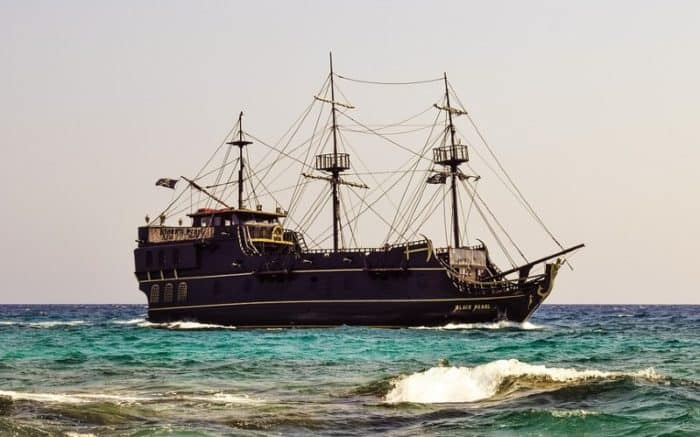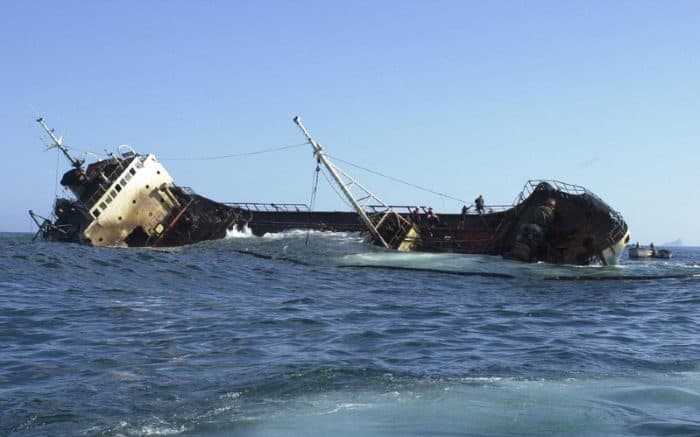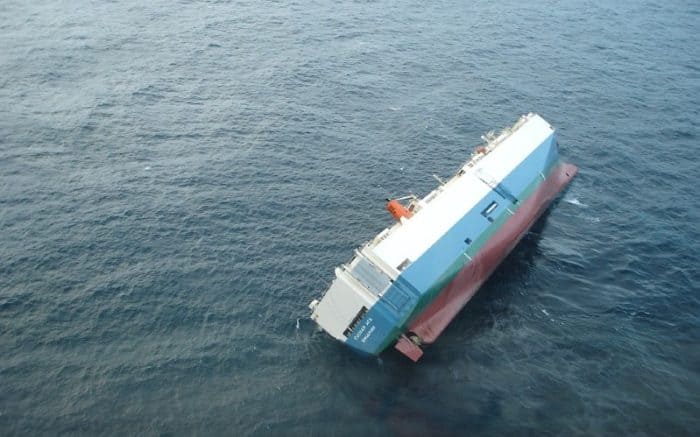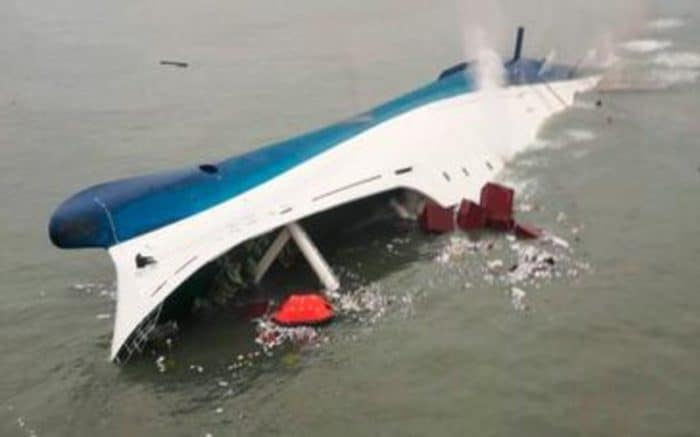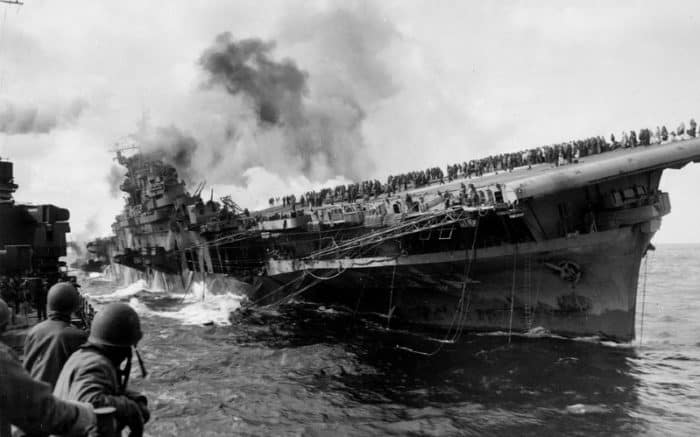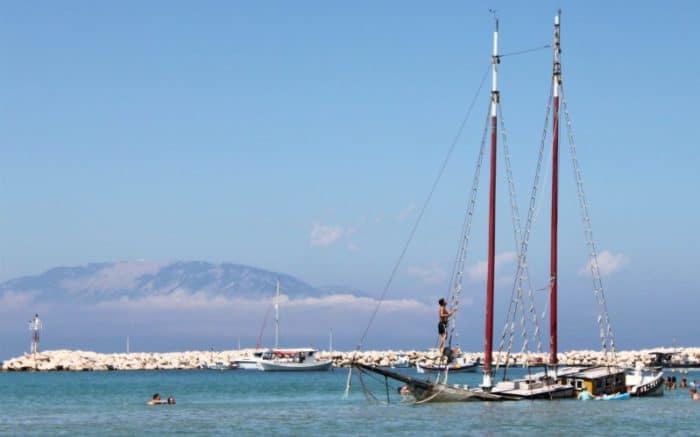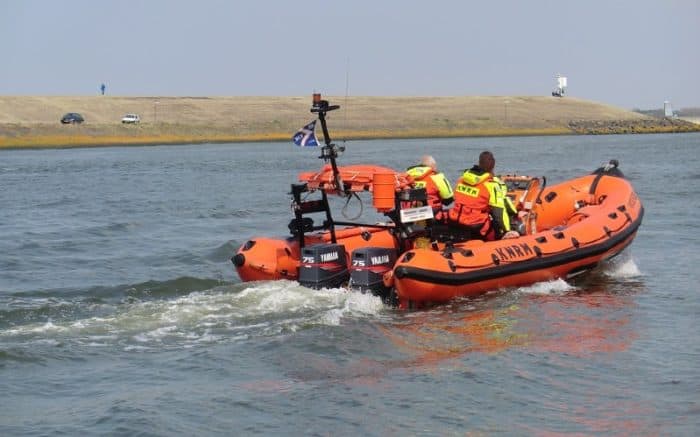Why the Captain Goes Down with the Ship
Everyone has heard that the captain goes down with the ship. Most of us have probably not stopped to wonder where this saying comes from. Is it just a saying? Is it a rule? And if so, how long has it been around? And most importantly, why was it a tradition at all. There’s a lot to unravel here that most boaters are unaware of. Let’s take a lot at one of the most grim traditions in maritime history.
A Maritime Tradition and Maritime Law
One thing worth knowing is that it is not a law that the captain “goes down” with the ship. No country or ruling body has ever explicitly stated this. That means in the sense the captain needs to die on board. That said, there are laws about abandoning ship. Not every country adheres to this but some do. Nations such as Italy, Spain and Greece make it a crime to abandon the ship. International law also has standards set forth that a captain must follow. So as far as international law is concerned, a captain is not bound to stay on board. But that doesn’t get them off the hook.
According to customary international law, a captain has certain duties. They must operate under the principles of prudent seamanship. Prudent seamanship means they need to care for crew and passengers alike. They cannot do this if they leave the vessel.
There is something called the SOLAS convention that 161 countries follow. SOLAS stands for Safety of Life at Sea. It was put forth by the International Maritime Organization. The first version dates back to 1914. It came about after the sinking of the Titanic, in fact.
In 1974 the most recent version of the SOLAS convention was passed. In this version it does not state the words “the captain must stay on board.” However, it does clearly state that the captain has ultimate authority about the ship. A captain must “proceed with all speed” to help any people in distress.
SOLAS also states that every vessel needs an emergency plan. This plan must spell out who is responsible to do certain tasks in an emergency. It’s possible that such a plan would not specify the captain. That said, it’s unheard of that a captain would not be the one who is ultimately responsible. This is because, as we established, the captain has ultimate authority.
The idea that a captain would leave a vessel before it is evacuated is essentially unheard of. At least in theory. In practice, there have been times when this was the case. And those captains have also had to deal with consequences as a result.
The Origins of the Tradition
SOLAS was obviously not the origin of the idea that the captain goes down with the ship. It was, as we said, a direct response to the Titanic. And the captain of the Titanic was following the already established tradition. So where did that come from?
The Rolls of Oleron were written in France sometime before the year 1180. These are the oldest known writings on Maritime Law that we have. For centuries, these were the rules a captain was expected to follow.
The document was written to establish rules for shipping in Medieval Europe. The name comes from the Isle of Oleron in France, where they were written. Even when later laws were established, this was the document on which they were based.
When they were written, these laws dealt with the trade of wine between nations. They needed a set of rules for vessels who would be travelling up and down the coast. Imagine shipping products from Los Angeles to Seattle along the highway. Except now there are no rules of the road. You’d need to establish a procedure to ensure the safety of the cargo and the people shipping it.
By 1364, the Rolls of Oleron were basically set in stone for all of Europe. The document was translated and amended several times over the years. This allowed it to be adopted into law in other countries. It established a number of rules about maritime behavior including:
- If a ship is in port and the weather looks bad, the captain must ask his men what they think of the weather. If some say it looks safe and others say it looks bad, he must go with the majority.
- If a pilot’s ignorance causes a ship to lose or damage cargo, they must make amends. If he does not, he may be executed.
- If shipwrecked sailors are attacked when they come to shore, the Lord of that land is responsible. He must hold the attackers accountable. If the Lord allowed the attack, he will be burned in his own home and the land will be turned into a market for pigs and swine.
As you can see, the laws back then were a little more colorful. But it did establish a basis of basic behavior. Much of it dealt with preservation of both crew and cargo. There are rules about how and when a captain can throw cargo overboard to save a vessel in a storm. And others about trying to preserve that cargo.
These rules evolved to a natural conclusion. In order for a ship, its crew, and its cargo to be saved, someone had to be responsible. Even if all hope was lost, someone was at the end of the line to make that call. That was the captain. So, the captain had to be the last one to leave a ship no matter what. And sometimes that meant dying as well.
In modern times “going down with the ship” has come to mean self sacrifice. Oftentimes an unnecessary one. You may frequently hear it used in the context of someone doing something they don’t need to do. Or are even stupid for doing. You’re being loyal to the point of death. And really, that’s not actually the spirit of the rule at all. The captain does not have to die. In fact, it’s best if the captain survives. That means the order to abandon the ship was carried out well and everyone survived. But the spirit of the rule is that the captain needs to be willing to make the sacrifice. He has to be willing to put his own life on the line. And it’s about taking ultimate responsibility for passengers and crew.
How Regional Laws Change Things
Depending on where the ship hails from, there are other laws to consider. As we said, countries like Italy have their own rules about a sinking ship. According ti Italian Maritime Laws, if a captain is not the last person to leave a ship, he faces two years in prison. He can face up to 8 years if the vessel is lost as a result of him abandoning it. And if it was a ship that carries passengers, he faces 3 to 12 years.
In the United States, there is not a specific law against a captain abandoning ship. However, other laws can and do come into play. For instance, if a captain leaves the ship and there are passengers still on board, that could be a crime. If people die, that act of abandoning ship is now considered manslaughter. It’s essentially saying a captain has killed through negligence. They may not have wanted anyone to die, but it’s still their fault that it happened. So in a roundabout way, it can be considered law that a captain stays on board under US law.
This law doesn’t come into play very often, as you can imagine. It is not a frequent occurrence that a captain flees a sinking ship. One of the more recent cases was when a captain was charged with manslaughter in the 19th century. So not recently at all. Between 1976 and 2012, there were only 22 decisions regarding manslaughter at sea. None were relating to a captain abandoning ship.
The Danger of a Sinking Ship
You don’t need to be a mariner to see the problems with a sinking ship. The risk of death is very high. Drowning, freezing, being lost at sea, these are all risks. A captain’s obligation to ensure the safety of passengers and crew requires them on board. How would anyone reasonably coordinate an evacuation from a lifeboat?
The fact is, morally and logistically, being on board is imperative. The captain needs access to the radio. Even if it’s out, they need to see the condition of the ship. They need to be hands on in seeing where everyone is. As well, they need to know the condition of the vessel, the crew, the lifeboats, and more. If a captain abandons ship, they are limiting what they can do and the information they have access to.
Giving the Order to Abandon Ship
When it comes time to abandon ship, there is protocol. Giving the order to abandon the ship can’t be done lightly. Abandoning ship needs to follow rules. Certain conditions should also be met before the order is given.
- Fire. One of the most dangerous things to happen on a ship is a fire. From the smallest fishing vessel to a cruise ship, fire is a killer. If a fire has broken out and is no longer controllable, the order can be given. This is especially true if access to fire extinguishers is blocked. At that point, decisive action needs to be made. The order to abandon the ship is about preserving life. Until that point, however, every effort should be made to fight the fire.
- Sinking. Consider the Titanic again. The ship hit an iceberg, and the hull was compromised. There is no need at that point to consider options. Damage of that scale cannot be fixed. The order to abandon a sinking vessel is the clear choice. If a commanding officer has no hope of saving the ship, then he or she has to try to save the people on board. If a ship is already sinking, it can’t be saved.
- A variation to the sinking scenario is capsizing or collision. In these circumstances it’s vital to save passengers and crew. The order to abandon the ship should be given. The ship’s captain can then oversee the process of getting everyone to safety.
- If there has been a collision or other accident, the vessel will need an evaluation. The Captain and officers will need to make a decision. Sometimes this will have to be very quick, as you can imagine. If the nature of the damage is irreparable, then the Captain can order everyone to abandon the ship.
Capsizing vs Sinking
Just as a point of clarification, let’s discuss what it means for a ship to capsize or sink. The terms are often used interchangeably. Both are reasons for a captain to order a ship abandoned. However, they are not the same thing.
A sunken ship is a ship immersed in water as far as it can go. That means it has gone underwater and hit the bottom. This can happen in shallow water or the open ocean.
A capsized boat doesn’t necessarily sink. Instead, the boat could have become unbalanced and rolled to its side or flipped right over. The order to abandon the ship is reasonable. It’s unsafe for people to remain on a capsized ship. It’s also possible a capsized ship could eventually sink. However, it is not fully immersed in water and on the bottom yet.
Can a Captain Leave an Abandoned Ship?
This is one of the tricky ways that this tradition has real world implications. No one can state a captain has to die with a ship. Just imagine trying to make that a law. Even in the golden age of boating before planes were a thing, no one was dying if they didn’t have to. But the boat is and always will be the captain’s responsibility. That does have real and legal implications. The owners of the cargo on a ship have certain expectations.
Most captains of commercial vessels, passenger ships and so on don’t own those ships. They are, however, in charge. And just like if you are driving a friend’s car, you need to keep it in good condition. Crash it and you’re on the hook. And in the case of a vessel, there’s plenty more to be concerned about. The lives of the passengers and the value of the cargo are the captain’s responsibility.
Because the captain is responsible for the ship and everything on it, they can’t technically leave it. Not the same as any passenger or crew member can. But that doesn’t mean the captain needs to die with the ship. That would be just as counterproductive as the captain abandoning ship. A cowardly captain is about as useless as a dead one in these terms. Instead, a captain would have been expected to be responsible for the vessel and its crew.
Once the ship has sunk, the cargo would still be intact. At least some of it would be. The ship is now salvage. The captain has a duty to protect that for whoever put him in charge. A sunken ship was subject to any number of pirates or salvage hunters. So a captain needs to know where the ship sank. That will help with the efforts to get back and salvage what’s left, if possible.
For all of this to work, the captain should be the last person to leave a vessel. They need to ensure the lives of everyone on board are being taken into consideration. So the captain helps everyone abandon the ship and then does whatever he or she can after to aid in salvage. That’s the ideal, anyway.
Captain Smith and the Titanic
Obviously not every ship is sinking as a smooth operation. And sometimes the captain does, in fact, go down with the ship. Most people know that Captain Smith of the Titanic perished when that ship sank. He famously did not abandon his post as the ship went down.
There are some eye witness reports that say Smith was a hero on the Titanic. He spent his time trying to keep passengers calm and helping them get to lifeboats and to safety. Other stories say he bungled the entire operation. Whatever the truth may have been, Smith was one of the over 1,500 people who died when the Titanic sank. He did not abandon the ship and held true to the maritime tradition.
The Costa Concordia
In 2012, the Costa Concordia capsized near Italy and made international news. Images of the vessel on its side in shallow water were seen around the world. Captain Francesco Schettino also made news and not for a good reason. As passengers and crew attempted to get to safety, the Captain found his own way off the boat.
Now this disaster was not on the scale of the Titanic. That didn’t mean it was not serious. In fact, 32 people died as a result of the ship going down. For the captain to leave while people were still in peril was seen as a clear dereliction of his duty by many.
Three years later, Schettino was sentenced to 16 years in prison for his role in the incident. That was for crimes including manslaughter. It also included abandoning a ship with passengers still onboard. One year of his 16 year sentence was specifically for the crime of abandoning ship.
The Infamous Case of Captain Lee Joon-seok
In April 2014, the ferry known as MV Sewol left Incheon in South Korea. It headed out en route to Jeju. The trip was 264 miles and would take over 13 hours. There were over 450 passengers on board, including 325 high school students on a field trip. The boat had been purchased from Japan and was already 18 years old and in poor condition.
It was retrofitted illegally in Korea to include more space for passengers and cargo. Its gross tonnage was changed from just 239 tons to a staggering 6,825 tons. Passenger capacity increased from 116 to 956. The ship was known to be imbalanced with a shifted center of gravity. However, documents were falsified to allow it to be certified as safe.
On the morning that the Sewol sank, a fog warning had been issued. The boat was issued a maximum cargo allowance of 987 tons. It was carrying 2142 tons. They had not even adjusted the ballast from the previous voyage.
Captain Lee Joon-Seok was a replacement captain working on a one-year contract. The previous captain had complained that the vessel needed repairs. The company said they’d look into it but never did. It was later determined their annual budget for safety training was $2. They spent it on a paper certificate.
It was around 9 in the morning when the Sewol sank. They were passing through a channel when the ferry started listing starboard. The pilot made note that the steering was not responding. Attempts to compensate made it worse and the cargo rapidly shifted. That shift caused the boat to dip and take on water.
Power cut off, and the boat continued listing. A call went out over the intercom, telling passengers to remain where they were. Even as passenger quarters started filling with water, the warning was broadcast again. And then Captain Joon-Seok did the unthinkable. He personally told passengers to stay where they were. And then he abandoned ship.
The first emergency call did not come from the captain or crew. One of the high school students called for help. Three minutes later the crew called for help. Even as the boat sank, it was local fishing ships that arrived to save the fleeing passengers.
It was over a half hour later that the captain gave the order for passengers to abandon the ship. No one knows if that order was ever relayed to any passengers. It took two-and-a-half hours for the ferry to sink. Despite that, 304 passengers died, including 250 of the students. The captain was the first person to be rescued, along with several crew members.
South Korean law states a captain must remain onboard in a disaster. The Captain’s cowardly actions violated tradition and established law. He was punished accordingly. His actions would have been abhorrent if he had just jumped ship. Instead, he made people stay where they were. The children who stayed were listening to an authority figure. Many of them never even left their rooms. They would have been trapped until it was too late to do anything. Most of the ship’s life rafts were still securely stowed on board.
The captain was sentenced to 36 years for negligence. At the time he was acquitted of homicide charges. Later, an appellate court reinstated the homicide verdict and he was given life in prison.
Ships in Wartime
A naval captain has different responsibilities than a civilian. This would be on the same level as desertion and warrant official charges. This includes a court martial and likely a dishonorable discharge. There are exceptions, of course. If a captain were to abandon the ship as part of a greater plan to save the vessel, then that would be reasonable.
Some captains have gone above and beyond to save the crew. One of the most incredible comes from the Second World War. Commander Gilmore of the USS Growler came under attack by a Japanese gunboat. The submarine was on the surface when it came under fire. Gilmore and several others were shot.
Realizing that his crew would die if he didn’t act, Gilmore ordered everyone below. Critically injured, he stayed on deck and gave the order to submerge. The crew closed the hatch, and the submarine dived. It was the last time Gilmore was ever seen. His actions saved his crew but left them without a captain. Gilmore was awarded the Medal of Honor for distinguished gallantry as a result.
Beyond the Maritime
The tradition of not abandoning ship goes out of the water as well. Captain Richard Ogg proved this in 1956. Captain Ogg was the pilot of Pan Am Flight 6 which suffered multiple engine failures. The plane went down in the Pacific Ocean. Ogg stayed on board to help coordinate the evacuation of passengers and crew. A Coast Guard vessel was able to save every passenger and Ogg.
Metaphorically speaking, a captain going down with the ship can appear anywhere. It means standing by a decision even if it causes you to suffer in the long run. It also refers to being ultimately responsible for not just yourself but others.
The term tends to pop up in business these days more than anywhere. If a company makes a poor decision or suffers due to external causes, someone is to blame. Usually the boss is the one who goes down with the ship in these cases.
What If You’re a Captain of Your Own Boat?
So let’s say you’re on the water in your bass boat with a few friends. It’s yours, it’s your responsibility. Unless you relinquished that responsibility to someone else and everyone has acknowledged it. And even if someone else is behind the wheel, you are ultimately responsible. If someone gets into an accident on your boat, you can still be held liable.
But for now, let’s say you’re in charge. Most people will call you a boat operator or boat owner. Captain is usually reserved for people who have legitimately earned the rank. Legally you are called a licensed boat operator in America.
You can call yourself the captain of your boat if you want. You could call yourself Master or Commander or whatever you choose. Legally, however, a captain is a title you have to acquire, not just give yourself. However, on the water, these are semantics. As the boat operator, you are still responsible for the boat and the people on it.
As a legal operator, there are duties you should perform. These are for your benefit as well as those of other boaters and your crew and passengers. Legally, your crew and passenger must be made aware of basic safety procedures on the boat. You have to cover this with them.
- Safety equipment. Passengers on your boat need to be aware of where safety gear is. This includes personal flotation devices and fire extinguishers. Visual signals like flares need to be pointed out. A bailer or water pump needs to be pointed out. Make sure they know where the first aid kit is as well.
- Every passenger needs access to a PFD. It needs to fit them as well.
- Every passenger needs to know when they must have a life jacket on. We recommend that everyone wear one at all times on board. However,the legal requirement is that they just have easy access. Tell your passengers when you need them to put one on. This could be in case of rough currents or bad weather.
- Cover basic procedures they need to follow. That means rules regarding behavior, especially reckless behavior. Also about dealing with waste, not dumping or throwing trash overboard. All passengers and boaters should understand basic boating courtesy. That means things like limiting wake around other boats. Or keeping noise down when you’re at an anchorage.
- Explain to passengers how any gear or cargo should be handled. This includes bring it on board, stowing it and unloading it.
- Cover basic procedures for moving on board. Some people, especially children, need to know how to safely navigate on board. Cover where people can sit and how they should move from one side of the boat to another.
- Calling for help. At least one passenger or crew member should know how to use the VHF radio. Cover how to make a Mayday call.
- How to handle the anchor. This includes drawing it in or throwing it out.
- Emergency procedures. Your passengers need to know how to handle an emergency. This includes what to do in a man overboard situation. Also things like fire or a collision. You should give out roles before you depart. Everyone should know before you leave what they are expected to do. This cuts down on confusion in an emergency. Often you have little time to react on the water, so this is important. Someone should be able to cover for you if you are incapacitated in some way. That could just be basic functions to get you and others to safety. At least one passenger should know how to safely operate the boat.
- Personal rules. This is not a legal requirement at all. However, you’re in charge, so it’s still your responsibility. If you don’t want people to drink on your boat, say so. Likewise, if you want to limit smoking, loud music, or anything else. You set the tone and people should respect your position.
Just like the captain of a cruise ship or a naval vessel, you have duties. You are responsible for the people on board. This is the same as if you’re driving a car. If you’re negligent and hurt other drivers or your own passengers, it’s on you. In the eyes of the law, a boat is essentially a tool. It’s a car, it’s a chainsaw, it’s fireworks. If you are not responsible with it and it’s yours, you will be responsible for its misuse.
In terms of people, you just need to be aware of your crew at all times. You need to make sure they are following the rules. And in the event of an emergency you need to take reasonable steps to ensure their safety. The reason for this is simple. You invited these people on your boat.You took on the responsibility for them when you did so.
How to Abandon Ship
Despite the way it sounds, you can’t just yell “abandon ship” and jump overboard. This is especially true on larger vessels. There are procedures that should be followed.
If it has been determined that there is no other choice but to abandon the ship, procedures can begin. A captain should inform the Engineer on Watch of the order to abandon the ship. The order can then be given over the ship wide PA system. This is a simple “abandon ship” command. It can be repeated over the PA and should be followed by all crew and passengers immediately. This is a verbal command, so the meaning is clear to all. The sound signal for abandon the ship is six short blasts followed by one long blast. This can be done with the ship’s horn or whistle. This signal is sometimes mistaken for a general alarm. That’s why it’s important to have the verbal order issued as well.
The captain can now initiate a distress call. The order to abandon the ship should be given before a distress call in an emergency such as this. There are times, however, when the reverse order may happen. If the situation did not seem as dire as first, a distress call may be placed first. Then, as the situation grows worse, it may become apparent that an abandon the ship order is needed. However, if this is the case, the captain should also make a distress call to inform rescuers.
A distress call can be made over the radio. Visual distress signals should also be used. Things like flares can be fired. These are all important in helping rescuers find the vessel.
The EPIRB should be activated. That stands for Emergency Position Indicating Radio Beacon. This will help rescuers locate the vessel. A Search and Rescue Transponder should be put on the lifeboats as well. Like visual signals, these are essential for rescue. The reason so many signals are given is that it can be extremely hard to find a vessel. A ship at sea in bad weather is a needle in a haystack. If it’s sinking, the window to find it is limited. It may be completely sunk by the time rescuers arrive. These signals are needed to help save lives. Plus, in many cases, not all signals will be given. The situation is frantic and people forget some things.
Captain and crew should help passengers onto life rafts at this point. Everyone should be outfitted with a personal flotation device. If possible, the captain should be keeping a tally of everyone abandoning ship. This can later be compared to the manifest.
The captain can now collect any documents or logs. In this case it will just be what may be needed in investigating the accident later. This should only be done if there is time. The first priority is to the passengers and crew. Every person should be off the boat before this is done.
Once everyone has safely left the vessel, the Mayday can be cancelled. The captain should communicate to rescuers or emergency crews. They need to explain why the ship was abandoned. They should also perform a headcount at this point. They should then report the number of survivors to authorities.
Once rescue has been finished, the captain will be required to file a report. That’s how it should all work. Obviously, in a life and death emergency, things do not always go as planned. Sometimes the best you can do has to be good enough. As long as efforts are made to save lives, things like logs and records can be worried about later on.
The Bottom Line
Being the captain of a ship entails a lot of responsibility. They need to be aware of the ship, its cargo, its crew, and other ships at sea. The captain can be held responsible for damage to any of those things. Every effort needs to be taken to make sure everyone and everything gets to shore in one piece.
During a disaster, the captain is the last line of defense. They are the calm in the storm. Because the captain is in charge, they are who everyone else looks to for guidance. In many ways, it can be a heroic role. It really tests the mettle of a person. As we have seen, not everyone is up to the task.
The captain goes down with the ship for the good of everyone on the ship. The goal is to ensure no one else has to go down with the ship. If things go as planned, the ship will be lost, but all lives will be saved. If things go poorly, then the captain should have done everything they can. It’s about helping others to the best of your ability. Essentially, it’s an ideal that became a rule.
Hopefully all the rules are followed and safety procedures are observed. If that’s the case you’ll never have to experience how this works for yourself.
Categories: Boats
